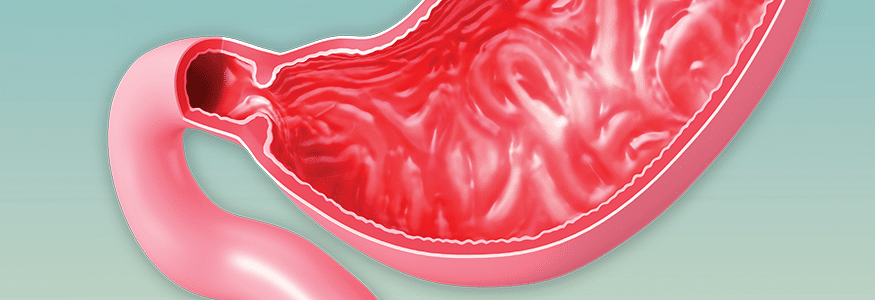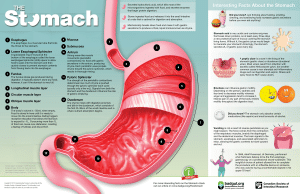Download a PDF Version of the Stomach Infograph
The Stomach
The stomach is a J-shaped organ that lies between the esophagus and the small intestine. It has three main functions:
- Stores ingested food and releases it into the small intestine at a rate that is optimal for digestion and absorption.
- Secretes hydrochloric acid, which kills most of the microorganisms ingested with food, and secretes enzymes that begin protein digestion.
- Mechanically breaks down food and mixes it with gastric secretions to produce a thick, liquid mixture known as chyme.
Esophagus
The esophagus is a muscular tube that links the throat to the stomach.
Lower Esophageal Sphincter
A specialized ring of muscle at the bottom of the esophagus called the lower esophageal sphincter (LES) opens to allow food to pass into the stomach and then quickly closes to prevent stomach contents from flowing back into the esophagus.
Fundus
The fundus stores gas produced during digestion. It typically doesn’t store any food; however, it can if the stomach is very full.
Body
The body’s volume is ~50mL when empty. Food is stored in here until it is ready to move into the small intestine. Eating triggers receptive relaxation that allows the stomach to expand to ~1L. Consuming more than 1L of food can cause over-distension, creating a feeling of fullness and discomfort.
Antrum
Strong wave-like muscle movements (peristaltic contractions) mix food with gastric secretions in the antrum, producing chyme. Each peristaltic wave propels chyme toward the pyloric sphincter, which results in thorough mixing.
Pyloric Sphincter
The strength of the peristaltic contractions determines how much chyme is pushed through the pyloric sphincter each cycle (usually only a few mL). Signals from both the stomach and the duodenum influence the rate of gastric emptying.
Duodenum
The chyme mixes with digestive enzymes and bile in the duodenum, which consists of the first 25-38cm of the small intestine and is where nutrient absorption begins.
Interesting Facts About the Stomach:
- Just thinking about tasting, smelling, chewing, and swallowing food increases gastric secretions before you even eat anything! Amazingly, the stomach secretes 2L of gastric juice every day.
- Stomach acid is very acidic and contains enzymes that break down proteins, so at least every three days a new protective layer of mucus covering the stomach lining forms. Without it, the gastric juices would begin to macerate your stomach!
- A peptic ulcer is a sore in the lining of the stomach (gastric ulcer) or duodenum (duodenal ulcer). Most ulcers result from infection with bacteria called Helicobacter pylori, but another common cause is non-steroidal anti-inflammatory drugs such as ibuprofen and aspirin. Stress and spicy food do NOT cause ulcers.
- Emotions can influence gastric motility. Depending on the person, sadness and fear tend to decrease motility whereas anger and aggression tend to increase it. Intense pain in any part of the body inhibits motility throughout the digestive tract.
- The stomach only absorbs certain medications (like aspirin) and small amounts of alcohol.
- Vomiting is not a result of reverse peristalsis as you might expect. The force comes from the contraction of the respiratory muscles, (mainly the diaphragm) and the abdominal muscles. The brain signals to the stomach, esophagus, and associated sphincters to relax, allowing the gastric contents to travel upward and out.
- Cells that form the wall of the stomach (parietal cells) secrete a protein called intrinsic factor, which is required for the absorption of vitamin B12. The intrinsic factor-vitamin B12 complex binds to a special receptor in the small intestine where it gets absorbed.
- In 1868, Adolf Kussmaul, of Germany, performed what historians believe to be the first esophago-gastroscopy on a professional sword-swallower. This insightful choice of patient allowed him to complete the procedure with an inflexible device on someone who was used to having uncomfortable objects in his GI tract!
Want to learn more about the stomach and digestion?
We have several related articles that may be helpful:
- Digestion
- Digestive Fallacies
- Ulcer Disease
- 3000 Year Old Thoughts on Digestion
- Diet and the Development of Stomach Cancer
- Gastroparesis
- The Unassuming Wonders of the Esophagus
- The Liver



